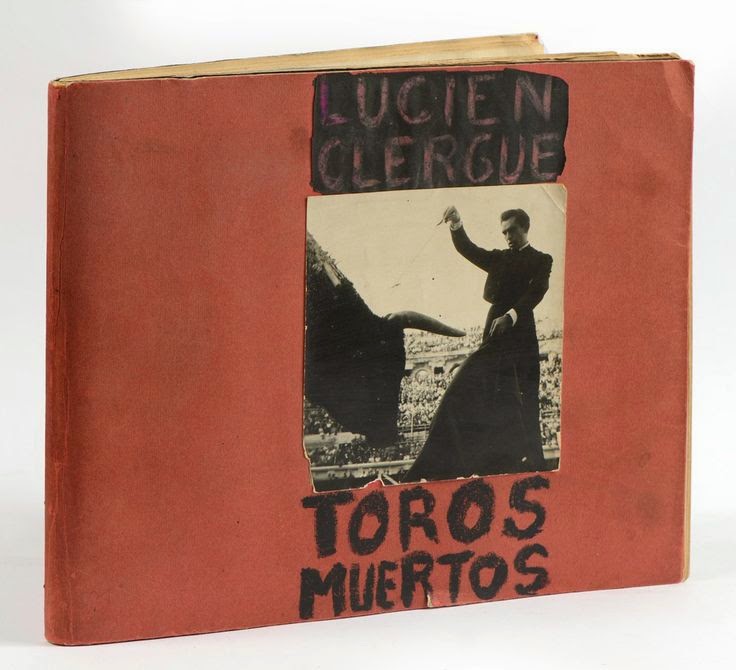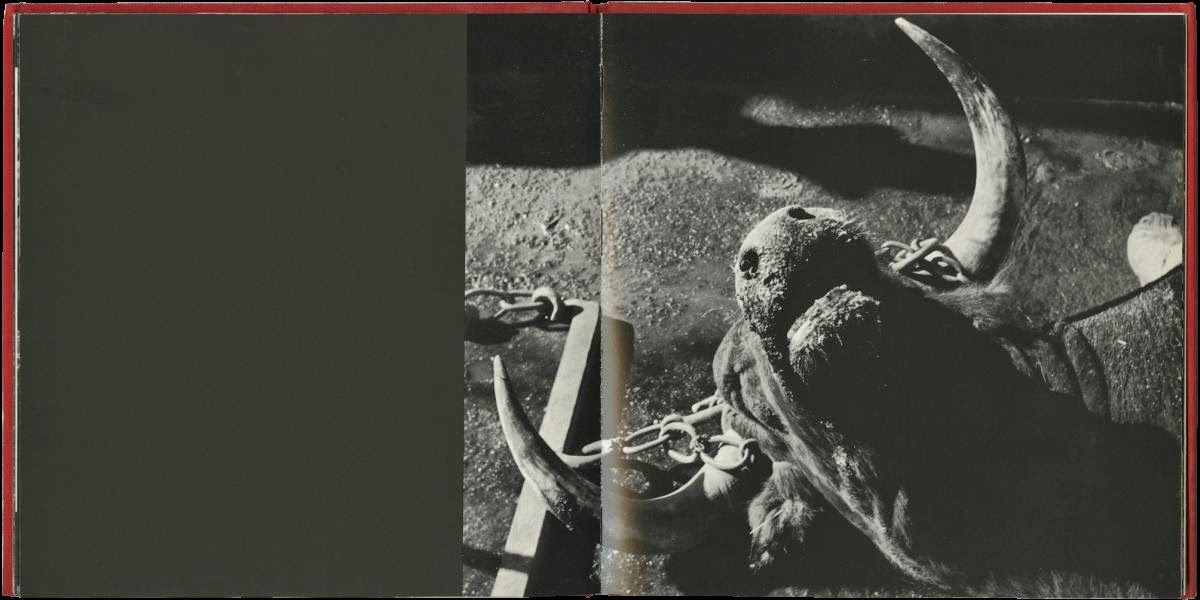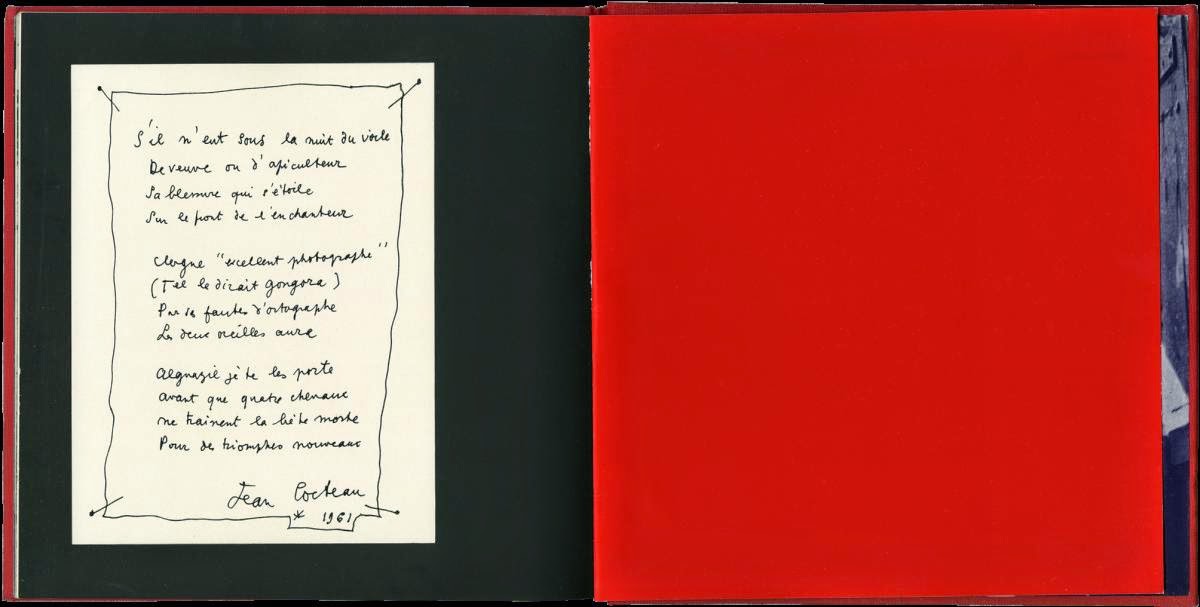Lucien Clergue toros muertos. Maquette préparatoire de l’ouvrage toros muertos, composé de 25 photographies, tirages argentiques d’époque, mise en page par l’auteur. Album 245x310mm Estimation 8000-10000 €
![Lucien Clergue Lucien Clergue Kunsthaus Vienna 2007 300x208 Lucien Clergue ★]()
Les hommes et les femmes de Lucien Clergue from Les Rencontres d'Arles on Vimeo.
Lucien Clergue was born into the family of a grocer in Arles, southern France, on August 14, 1934. His parents separated when Lucien was 7. His mother was disabled and all her life dreamed of a better lot for her son. She wanted him to be famous and to have a career in the arts. At 7, he started taking classes from a famous local violinist: his mother wanted her son to go to the conservatoire and become a composer.

Lucien Clergue
Life willed differently, though. At 16, Lucien had to quit school and start working at their grocer’s shop, which his mother could no longer manage. Then he found a job at a factory to earn a living for himself and his mother. In 1952 his mother died. Lucien had to work at the factory until he was 25.
It was his mother who had gifted an old camera to Lucien when he was 13. A local dealer in cameras taught him how to use it and gave him his first lessons in photography. He saw Lucien’s sincere interest in the magic equipment and allowed him to use cameras from his shop until they were sold.
Clergue was generally lucky in having meetings that influenced his life. He was quite young when all the most important events and acquaintances occurred and plunged him into creative endeavors. At 18, he met the writer Jean Marie Magnan, who was to support and guide him throughout his career. He told Lucien about the artistic environment of Paris, Picasso and Cocteau, Jean-Paul Sartre and the existentialists. The artist André Marchand told him about the photographers Man Ray, Marie-Laure de Noailles and Jean-Louis Barrault. At that time Lucien dreamed of a filmmaker’s career, inspired by movies of Roberto Rossellini, Vittorio De Sica, Luchino Visconti and Federico Fellini.
In 1953, leaving the Arles bullfighting arena, Lucien dared to approach the 62-year-old Picasso and show him his photographs. Picasso seemed interested and allowed Lucien to show him his works in two years’ time. Clergue worked throughout that period to prepare a portfolio and to live up to the Master’s expectations. He took pictures of everyday life in his native Provence and of postwar ruins. In 1954 he did a series of photographs of the production of The Death of Julius Caesar after Shakespeare, staged by Jean Renoir for the 2000th anniversary of Arles. His debut series of photographs, the “Saltimbanques”, presented traveling entertainers, acrobats and harlequins on the ruins of Arles.
When the period of probation was over, the young photographer finally met the artist of world renown. On November 4, 1955, they talked for more than five hours in Picasso’s house in Cannes, as a result of which Picasso promised to design a cover for Clergue’s first book and a poster for his first exhibition. Picasso kept his word. True, the organizers of the exhibition banned the poster. That meeting led to their real friendship that lasted for 30 years until Picasso died. In 1992 Clergue published a book, Picasso my Friend, to mark the 20th death anniversary of the Master.
For years Clergue became a protégé of Picasso, who introduced the young man to his friends. Thus, Jean Cocteau, who saw a photo artist in the young man, became a spiritual director for Clergue in 1956. Until Cocteau died in 1963, the two of them had been corresponding frequently, with Cocteau giving advice and recommendations to Clergue on behalf of his own and Picasso, with whom he discussed Lucien’s works.
Clergue’s first book was Corps mémorable. Poems by Paul Éluard, with a cover by Pablo Picasso and an introductory poem by Jean Cocteau. Lucien presented this book to Max Ernst, who bought his series Flamant morte sur la plage and became one of the first collectors of his works.
In 1959 Clergue did a series of photographs for Jean Cocteau’s film The Testament of Orpheus, in which he saw much that was close to his perception of life. Mirrors, through which one could enter the kingdom of the dead, were a metaphor for his own quest of the meaning of life. In the ruins of the castle he saw his parental home destroyed in the bombing of Arles.
This past spring (2011) we had a chance to see those works during the Fashion and Style in Photography festival at Moscow’s Multimedia Art Museum. Of course, one series of photographs is not enough to pass judgment on Clergue’s works.
In 1956 Lucien met Georg Schmidt, director of the Kunstmuseum Basel, in the castle of the British art collector Douglas Cooper, a friend of Picasso’s. Clergue was invited to exhibit at the museum. His exhibition received 25 negative versus three positive reviews. However, every cloud has a silver lining: the museum simultaneously hosted the famous “Family of Man” exhibition, which had been brought from New York by the photographerEdward Steichen, MoMA’s photography department curator. He bought ten photographs from Clergue’s exhibition for the МoМА collection. At the same time Schmidt passed on to Clergue an invitation from a certain Dr. Willy Staehelin to take pictures of his house built of glass and concrete after a design by the architect Marcel Breuer, who had taught at the Bauhaus in the 1920s. Thus, the flopped exhibition brought Clergue into contact with important people who largely influenced his life.
In 1961, at the invitation of Edward Steichen, Clergue exhibited at “Diogenes with Camera No. 5” at МoМА, New York, together with Bill Brandt and Yashuhiro Ishimoto.
In 1962 Lucien Clergue launches a 60-min. TV program À propos de la Ville d’Arles. Journal de voyage.
In 1963 two books of Clergue – photographs for The Birth of Aphrodite by García Lorca and Toros Muertos by Jean Cocteau – are published practically simultaneously in Paris, Stuttgart and New York. On the basis of his photo sessions in New York and Rio de Janeiro Lucien designs a collection of kerchiefs and scarves for Givenchy. In all fairness it should be pointed out that Clergue always rejected commercial offers from the Vogueand Paris Match magazines, guarding his independence as a photo artist.
The signal Camargue/Marais series of photographs appeared in 1965. That same year Clergue undertook to develop photo art culture – on his initiative and with his direct involvement the Musée Réattu in Arles set up a department of photography. After his friend Jean-Maurice Rouquette had been appointed museum director, Clergue had the idea of building a top-class collection of photographs in the museum. He wrote to forty of the world’s greatest photographers to solicit gifts for the museum collection. Practically all of them obliged and sent their works, including Henri Cartier-Bresson. A rich American collector made a gift of a collection of photographs, among them many works of Edward Weston.
In 1966 Clergue received the Prix Louis Lumière for his first black-and-white short film Le drame du taureau, released a year earlier. The French TV airs two programs about Clergue’s works.
In 1969 Clergue became director of the Arles festival and, together with Jean-Maurice Rouquette and the writer Michel Tournier, organized the Rencontres d’Arles seminars for photographers. This festival of photography has become a landmark event that for more than forty years has been staged in Clergue’s native town.![Lucien Clergue Lucien+Clergue+Curated+Christian+Lacroix+Vernissage+9n6c0M5fiXNl Lucien Clergue ★]()

In 1970 Clergue made a round-the-world journey, during which he met in Carmel the American photographer Ansel Adams, famous for his landscape photography, in particular his illustrious pictures of the Grand Canyon and theYosemite National Park (California). Adams attended the Arles festival in 1974 and 1976 while Clergue came to work in his Yosemite studio several times between 1971 and 1983.
In 1974 Clergue began to teach first at the University of Provence in Marseilles and then, in 1982, opened the National School of Photography, where he held a professorship. In 1983 he lectured at the Ansel Adams School in Carmel. In 1990 Clergue became the first foreigner to teach at the Osaka School of Photography (Japan).
Clergue invariably takes part in conferences on Pablo Picasso and Jean Cocteau as a loyal friend and one of the few contemporaries of theirs who is still alive. He is also a permanent member of numerous photo contests in Europe, Asia and America, conducts photo conferences and mounts exhibitions at many American universities.
Years passed by but Clergue’s interest in the cinema, another visual art, endured. In 1967 he made a film, Delta de sel, which was shown at the Cannes festival and nominated for an Oscar. In 1990 he made a film about the bullfighter Jésulin de Ubrique.
An indefatigable experimenter, Clergue began to make Polaroid pictures (including large-format ones) when he developed eye problems in the early 1980s . He also experimented with overlaying images and took up photo collage.
In 1975 he ventured into color photography in addition to his exclusively black-and-white pictures made earlier.
True to his passion for music, Clergue continues to play the violin and takes part in unique musical performances. In 1992 he presented his Provence – 4 Seasons slideshow within the framework of les Provenciades to the accompaniment of the Marseille Symphony Orchestra. In 1993, together with pianist Kochoyan, Clergue produced an audio-visual performance Jazz y Toros at the Nîmes Opera Theater, later shown at the Arles Festival of Photography.
Stage design is also in the focus of Clergue’s attention. He made stage sets for the following ballets:
- Le Jour où la terre trembla (Ballets Modernes de Paris, 1959);
- Orlando Furioso (La Fenice Theater, Venice, Italy, 1972);
- Le Fils du Vent after Jean Cocteau (1963, remained unproduced because of Cocteau’s death).
For years on end portrayal of female nudes has been a favorite theme with Clergue. He photographed nudes in the woods, the sands of the Nevada desert, in sea waves, and in Paris and New York streets, emphasizing bodily shapes by the play of light and shade in the Zebra nude series. In his countless trips around the world Clergue developed the theme with different models, opening workshops in various cities. His devotion to this theme has won him scandalous reputation – the Fidel Castro administration barred him from visiting Cuba in 2001.
His works are in many museum and private collections. In 1975 the National Museum of Modern Art purchased 60 of Clergue’s photographs for the Centre Georges Pompidou collection. In 1994 New York’s MoMA received a gift of ten photographs of Clergue. That same year the European House of Photography of Paris acquired six photographs of bullfights.
Clergue’s fans are largely indebted to his first Swiss collectors and patrons, Marina and Willy Staehelin and Charlotte and Dr. Willy Reber. They began to buy Clergue’s photographs from the Zurich exhibition in 1960 and from the Basel exhibition in 1961 and continued collecting his works for 35 years. Such stable financial support at the start of his career meant a lot for the young photographer and enabled him to remain an independent photo artist for long. Dr. Willy Reber died in 1995 and Willy Staehelin in 1996. Charlotte Reber decided to preserve the collection intact and gave it as a gift to the Harvard University Art Museums in 1996. Marina Staehelin ![Lucien-Clergue_8535 AVT Lucien Clergue 8535.pjpeg 200x300 Lucien Clergue ★]() offered the collection to several Swiss museums, but unfortunately none of them could afford buying the whole of the collection, as a result of which many photographs and portfolios were auctioned by Christie’s, Sotheby’s and German and Swiss auction houses. The antique market was already familiar with Clergue: from 1995 on Sotheby’s and Christie’s (New York), Maitre Beaussant Lefèvre and Tajan (Paris) and Maitre Fleck (Marseilles) have had his works on offer.
offered the collection to several Swiss museums, but unfortunately none of them could afford buying the whole of the collection, as a result of which many photographs and portfolios were auctioned by Christie’s, Sotheby’s and German and Swiss auction houses. The antique market was already familiar with Clergue: from 1995 on Sotheby’s and Christie’s (New York), Maitre Beaussant Lefèvre and Tajan (Paris) and Maitre Fleck (Marseilles) have had his works on offer.
 offered the collection to several Swiss museums, but unfortunately none of them could afford buying the whole of the collection, as a result of which many photographs and portfolios were auctioned by Christie’s, Sotheby’s and German and Swiss auction houses. The antique market was already familiar with Clergue: from 1995 on Sotheby’s and Christie’s (New York), Maitre Beaussant Lefèvre and Tajan (Paris) and Maitre Fleck (Marseilles) have had his works on offer.
offered the collection to several Swiss museums, but unfortunately none of them could afford buying the whole of the collection, as a result of which many photographs and portfolios were auctioned by Christie’s, Sotheby’s and German and Swiss auction houses. The antique market was already familiar with Clergue: from 1995 on Sotheby’s and Christie’s (New York), Maitre Beaussant Lefèvre and Tajan (Paris) and Maitre Fleck (Marseilles) have had his works on offer.Clergue has published 75 books, both illustrating literary pieces and albums of his photography.
Lucien Clergue has made a great contribution to the development and popularization of French photo art and has been highly appreciated at home. In 1980 President Valéry Giscard d’Estaing of France awarded him the Order of Merit, in 2003 Clergue became the holder of the Order of the Legion of Honor, and in 2006 became the first photographer to be elected to the Académie des Beaux-Arts de France. He is also a member of the Arles Academy of Arts (1974).
Lucien Clergue, Toros muertos, Éditions Forces vives, Paris, 1963 [postfaces de Jean Cocteau et Jean-Marie Magnan]. Aperçu de l’ouvrage.
Réalisée par Jean Petit, cette plaquette publiée à Paris aux Éditions Forces vives en 1963 réunit vingt-huit photographies de Lucien Clergue et s’achève par les postfaces de Jean Cocteau et de Jean-Marie Magnan, tous deux proches de Clergue et aficionados comme lui. À ce propos, Cocteau écrit : « Il m’est arrivé, aux arènes de Nîmes et d’Arles, au lieu de regarder le duel central, de suivre Clergue en chasse autour de la piste. Rien de plus singulier que ce spectacle d’un merle à qui le bec jaune d’une casquette ajoute une ressemblance, sautillant et vif, son œil rond tendu vers les moindres manifestations de l’extraordinaire » (Jean Cocteau, Lucien Clergue, catalogue de l’exposition organisée par Pierre Chanel, Lunéville, 1964).
CLERGUE, Lucien. El Cordobes. (Paris): Le Jeune Parque, (1965). Small square quarto, original red paper-covered boards.
First edition, Clergue’s brilliant photobook of famed matador El Cordobés, with 77 dramatic black-and-white photogravures of the charismatic torero whose courage made him a legend.
A founding member of Expression Libre in 1964, Lucien Clergue has produced, in El Cordobesand in works such as Toros muertos (1962), singular photobooks where he “transports us right into the ring” and captures some of “what are arguably the best photographs ever taken of the bullfight” (Parr & Badger I:219). Here Clergue follows the matador Manuel Benítez Pérez—El Cordobés—whose celebrated courage and flamboyance in the ring made him the most highly paid torero in history by the time of his retirement in 1971. With essays by Paco Tolosa, Robert Marteau, Jean-Marie Magnan, J.-M. Goudard and D. Maïsto. Text in French.



















